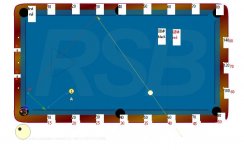Side Pocket Kid said:
I know some Hustlers at the main street pool rooms that know the Diamond System like the back of their hands.
Can kick out of any safety and can pretty much pocket most of the bank/kick shots that come up.
If anyone can throw in a crash course on the most important factors.
 http://endeavor.med.nyu.edu/~wei/pool/
http://endeavor.med.nyu.edu/~wei/pool/
Bruce is right in that there are a LOT of variables on every table that can effect the "perfect" diamond system. But... you can figure out with one or two shots on the table before you play whether the table is going long or short or whatever.
Daimond systems can be complicated or can be simple. I always tried to count diamonds, add, subtract, etc., but that has changed. I just look at line ups... there are particular diamond to diamond line ups for One, Two, Three, four and Five rail kicks. They WILL change slightly from table to table, or even if the temperature or humidity changes in the pool room while your playing. You must, as Clint Eastwood said in Heartbreak Ridge "Adapt and overcome".
No way there is space on here to explain all the lineups and variables, and adjustments that must be made when your "X" number of diamonds down table, or close to a cushion or a multitude of other variables. Just find someone to show you the basic system and work from there.
BTW, when I get on a table, usually the first thing I do is set up the cue ball on the alignment for a 5 rail kick to the corner, fire it and see if the table is long, short or dead on. Once you learn the systems, you'll learn to adjust from that shot.
Maybe someone has a good link they can post for diamond systems... I don't know of one, but I'm sure there's one out there somewhere.
Later,
Bob

